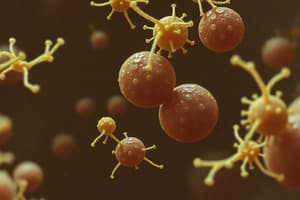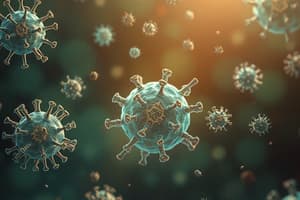Podcast
Questions and Answers
What is Bacteriology primarily concerned with?
What is Bacteriology primarily concerned with?
- The study of bacteria (correct)
- The study of infections caused by microorganisms
- The study of fungi and yeast
- The study of microbial ecosystems
Which statement accurately describes the role of microbes in photosynthesis?
Which statement accurately describes the role of microbes in photosynthesis?
- Only plants are responsible for photosynthesis.
- Microbes contribute to more than 50% of Earth's oxygen. (correct)
- Photosynthesis is not related to microbial activities.
- Microbes produce less than 30% of Earth's oxygen.
Which branch of microbiology deals with the immune response to disease agents?
Which branch of microbiology deals with the immune response to disease agents?
- Parasitology
- Mycology
- Immunology (correct)
- Virology
What is one of the primary functions of Environmental Microbiology?
What is one of the primary functions of Environmental Microbiology?
What distinguishes the Woese-Fox 3 Domain System from the traditional Whittaker 5 Kingdom System?
What distinguishes the Woese-Fox 3 Domain System from the traditional Whittaker 5 Kingdom System?
Which of the following is a modern application of microbes in biotechnology?
Which of the following is a modern application of microbes in biotechnology?
What are prions best characterized as?
What are prions best characterized as?
In the scientific nomenclature system introduced by Linnaeus, how is the genus name formatted?
In the scientific nomenclature system introduced by Linnaeus, how is the genus name formatted?
Which group of microbes lacks peptidoglycan in their cell walls?
Which group of microbes lacks peptidoglycan in their cell walls?
What type of reasoning begins with specific observations to form a generalization?
What type of reasoning begins with specific observations to form a generalization?
What is a characteristic of viruses?
What is a characteristic of viruses?
Which of the following is NOT a characteristic of fungi?
Which of the following is NOT a characteristic of fungi?
Which microbe is known for being part of a food chain and producing molecular oxygen?
Which microbe is known for being part of a food chain and producing molecular oxygen?
Which agent is responsible for Bovine Spongiform Encephalopathy (BSE)?
Which agent is responsible for Bovine Spongiform Encephalopathy (BSE)?
What cellular structure is found in eukaryotes but not in prokaryotes?
What cellular structure is found in eukaryotes but not in prokaryotes?
Which of the following is true about protozoa?
Which of the following is true about protozoa?
Flashcards are hidden until you start studying
Study Notes
Microbiology Overview
- Microbiology studies organisms that are too small for the naked eye, collectively known as microbes.
- Microbes, often termed "germs" or "bugs," include bacteria, viruses, fungi, algae, protozoa, helminths, and prions.
Branches of Microbiology
- Bacteriology: Study of bacteria.
- Mycology: Focuses on fungi and yeasts.
- Virology: Explores viruses and their behavior.
- Parasitology: Examine parasitic protozoans and helminths.
- Immunology: Investigates immune responses to diseases and allergens.
Specializations in Microbiology
- Epidemiology and Public Health: Investigates disease distribution and control measures.
- Food Microbiology: Studies the role of microbes in food production.
- Agricultural and Veterinary Microbiology: Involves microbes in enhancing crop and livestock yields.
- Environmental Microbiology: Examines impacts of microbes on the environment.
Importance of Microbiology
- First bacteria emerged approximately 3.5 billion years ago.
- Microbes contribute over 50% of Earth's oxygen through photosynthesis and play a vital role in decomposition and nutrient recycling.
Beneficial Uses of Microbes
- Microbes aid in extracting copper from ore, synthesizing drugs, hormones, and enzymes.
- They are utilized in bioremediation to degrade organic matter and detoxify pollutants, including oil spills.
Modern Applications of Microbes
- Biotechnology: Microscale biochemical factories for producing food and chemicals.
- Genetic Engineering: Employs molecular biology techniques for modern applications.
- Gene Therapy: Replaces defective genes in human cells.
- Genetically Modified Bacteria: Protect crops from pests and environmental stress.
Infectious Diseases Monitoring
- Department of Health (DOH): Tracks notifiable diseases.
- National Institute for Health, Research Institution for Tropical Medicine: Publishes disease data in the Philippines, including the Morbidity and Mortality Weekly Report (MMWR).
- World Health Organization (WHO): Monitors global disease outbreaks as part of the UN.
Microbial Taxonomy
- Traditional Whittaker 5 Kingdom System: Classifies organisms based on their structural and functional characteristics.
- Woese-Fox 3 Domain System: Groups based on genetic similarities and evolutionary relationships.
Nomenclature in Microbiology
- Binomial nomenclature system introduced by Linnaeus assigns each organism a two-part name: genus and species epithet.
- Scientific names are italicized or underlined, with the genus capitalized and species in lowercase.
- After first mention, names can be abbreviated (e.g. Escherichia coli to E. coli).
General Characteristics of Microbes
- Prokaryotes: Lack a nucleus and membrane-bound organelles.
- Eukaryotes: Contain a membrane-bound nucleus and organelles.
- Acellular agents: Consist of either DNA or RNA, with recent additions being proteinaceous.
Microbial Size and Characteristics
- Microbial sizes range from 10 nm (nanometers) to 100 µm (micrometers).
- Bacteria: Prokaryotic, have peptidoglycan cell walls, reproduce via binary fission.
- Archaea: Prokaryotic, lack peptidoglycan, thrive in extreme environments.
- Fungi: Eukaryotic, composed of chitin, forms include unicellular yeasts and multicellular molds.
- Protozoa: Eukaryotic, mostly saprobes/commensals, motile via pseudopodia, cilia, or flagella.
- Algae: Eukaryotic, possess cellulose cell walls, photosynthetic, crucial for oxygen production and the food chain.
- Helminths: Eukaryotic, multicellular animals, includes parasitic flatworms and roundworms.
- Viruses: Acellular, require a host to replicate, consist of DNA or RNA surrounded by a protein coat (capsid).
- Prions: Protein-based infectious agents linked to diseases like BSE and CJD.
Scientific Principles in Microbiology
- Science is defined as a methodical body of knowledge explaining natural phenomena.
- Qualities of a scientist include curiosity, open-mindedness, skepticism, creativity, and objectivity.
- Inductive Reasoning: Generalizations derived from specific observations.
- Deductive Reasoning: Testing of general ideas to prove or disprove hypotheses.
- The Scientific Method: Process involving hypothesis formulation, experimentation, data analysis, and conclusion drawing.
Studying That Suits You
Use AI to generate personalized quizzes and flashcards to suit your learning preferences.




